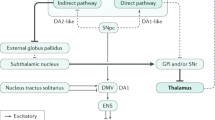Summary.
The progressive, neurodegenerative process underlying idiopathic Parkinson's disease is associated with the formation of proteinaceous inclusion bodies that involve a few susceptible neuronal types of the human nervous system. In the lower brain stem, the process begins in the dorsal motor nucleus of the vagus nerve and advances from there essentially upwards through susceptible regions of the medulla oblongata, pontine tegmentum, midbrain, and basal forebrain until it reaches the cerebral cortex. With time, multiple components of the autonomic, limbic, and motor systems become severely impaired. All of the vulnerable subcortical grays and cortical areas are closely interconnected. Incidental cases of idiopathic Parkinson's disease may show involvement of both the enteric nervous system and the dorsal motor nucleus of the vagus nerve. This observation, combined with the working hypothesis that the stereotypic topographic expansion pattern of the lesions may resemble that of a falling row of dominos, prompts the question whether the disorder might originate outside of the central nervous system, caused by a yet unidentified pathogen that is capable of passing the mucosal barrier of the gastrointestinal tract and, via postganglionic enteric neurons, entering the central nervous system along unmyelinated praeganglionic fibers generated from the visceromotor projection cells of the vagus nerve. By way of retrograde axonal and transneuronal transport, such a causative pathogen could reach selectively vulnerable subcortical nuclei and, unimpeded, gain access to the cerebral cortex. The here hypothesized mechanism offers one possible explanation for the sequential and apparently uninterrupted manner in which vulnerable brain regions, subcortical grays and cortical areas become involved in idiopathic Parkinson's disease.
Similar content being viewed by others
Author information
Authors and Affiliations
Additional information
Received November 5, 2002; accepted December 3, 2002 Published online March 5, 2003
Acknowledgements This paper was supported by the Bundesministerium für Bildung, Wissenschaft, Forschung und Technologie, the Deutsche Forschungsgemeinschaft (DFG), and Degussa (Hanau). The skillful technical assistance of Ms. I. Szász (graphics) is gratefully acknowledged.
Author's address: Prof. H. Braak, M.D., Institute for Clinical Neuroanatomy, J.W. Goethe University, Theodor Stern Kai 7, D-60590 Frankfurt/Main, Germany, e-mail: Braak@em.uni-frankfurt.de
Rights and permissions
About this article
Cite this article
Braak, H., Rüb, U., Gai, W. et al. Idiopathic Parkinson's disease: possible routes by which vulnerable neuronal types may be subject to neuroinvasion by an unknown pathogen. J Neural Transm 110, 517–536 (2003). https://doi.org/10.1007/s00702-002-0808-2
Issue Date:
DOI: https://doi.org/10.1007/s00702-002-0808-2




